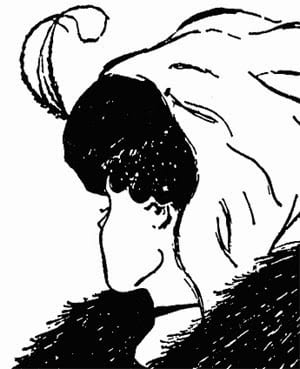When I look at this image, the first thing I see is an old woman and it’s hard to see anything else. But as soon as someone points out the young lady facing away from me in the same lines on the page, it is nearly impossible to see the old woman again. I am stuck with the view of the young lady.

In order to switch back and forth, I am forced to focus on certain parts of the image instead of looking at the whole. If I want to go back to the view of the old woman, I seek out the line of her mouth and raise my eyes up to her beak-like nose.
If I then want to see the young lady again, I look out to where her eyelash and nose are to shift perspective. And as I do so, I am reminded that I possess the same power of perspective in my daily life.
Perception is reality, right? So if we’re in a challenging situation, or a pattern in our lives where our default perspective is glass-half-empty, it’s up to us to change the way we look at it. The trick is not to fill up the glass, but to see that it is half full instead. We have to focus on certain parts of the whole that help us to see things in a different way, and it is important to teach our kids how to do this for themselves. As they hit adolescence and emotions become king, it can be really difficult to perceive things in a positive way, and once the negative patterns have been set, it takes work to change them.
If you have a teen who sees things in a decidedly unhappy way (I hate school, nobody likes me, I suck at math/history/lit), there’s no use challenging their perception. You will get nowhere by disputing their sense of reality or belittling their emotional responses, but you can help them turn the tide slowly by helping them see things in a different way. One powerful way to do this is to begin a gratitude practice (although you may not want to call it that).
When Eve started high school there were a lot of challenges and it didn’t take long for her to feel like a square peg in a round hole. After weeks of angst and hand-wringing (on my part), lots of conversations designed to build her up, and a few frustrated arguments, I decided to lead by example. Every night before turning my bedside lamp off, I texted Eve a list of three things I was grateful for and asked her if she had three to tell me about. I wanted the last thing in her mind before sleep to be happy. She started out slowly, often able to come up with one or two things, but sometimes getting stuck. It took a week or so before she was texting me first and asking for my reply, and her list of things has deepened from “my soft pillow” to items like “teachers I can trust” and her own strengths. Her perspective is shifting right before my eyes and I would be remiss if I didn’t say that it has made a difference in her willingness to get up and tackle each new day as it comes, challenges and all.
It is a practice, and, like the effort it takes to focus my eyes on one set of lines or another in that drawing when I want to see a certain perspective, it is continual. The best part about it, though, for me, is the reminder that I am ultimately in charge of which lenses I see the world through – hope or fear, scarcity or abundance, gratitude or anger – and I hope that my girls are learning that, too.



